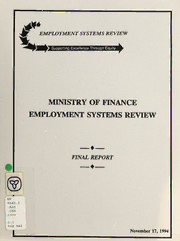
Employment Systems Review final report. PDF
Preview Employment Systems Review final report.
Jp* . 1 JgT EMPLOYMENT SYSTEMS REVIEW Supporting Excellence Through Equity MINISTRY OF FINANCE EMPLOYMENT SYSTEMS REVIEW FINAL REPORT HF 5549.5 . A34 .056 1994 C . 1 tor mai I November 17, 1994 Ontario Ministry of Finance DEC 1 6 1994 LIBRARY SERVICES (Toronto) TABLE OF CONTENTS PARTI • EMPLOYMENT SYSTEMS REVIEW Summary PART II • EMPLOYMENT SYSTEMS REVIEW Former Ministry of Revenue PART III • EMPLOYMENT SYSTEMS REVIEW Former Ministries of Financial Institutions and Treasury and Economics EMPLOYMENT SYSTEMS REVIEW Supporting Excellence Through Equity —♦—■ PARTI — ♦- EMPLOYMENT SYSTEMS REVIEW Su ary mu November 17, 1994 TABLE OF CONTENTS OVERVIEW 1 RECOMMENDATION SUMMARY 4 Key Recommendations 5 Recommendations For Each Employment System 6 Entry Systems 6 Retention Systems 9 Separation Systems 12 Recommendation Cross-reference Table 17 CHANGE STRATEGY SUMMARY 21 IMPLEMENTING CHANGE 22 Digitized by the Internet Archive in 2018 with funding from Ontario Council of University Libraries https://archive.org/details/employmentsystemOOonta OVERVIEW What is an ESR? An Employment Systems Review (ESR) is a tool to identify the existence of barriers in employment systems faced by members of designated groups and to develop a strategy to remove the barriers. Discriminatory practices create barriers that may also have an adverse impact on employees who are not members of a designated group. By eliminating these barriers, all employees can compete on merit. Employment systems include: ■ entry systems (recruitment, selection, orientation, probation) ■ retention systems (performance management, training and development, mobility, working conditions) ■ separation systems (discipline, exit/redeployment). Background A taskforce for the former Ministry of Revenue had already completed a significant part of its work when the former ministries of Treasury and Economics, Financial Institutions and Revenue were merged to form the Ministry of Finance. It was decided that the first taskforce should proceed, and that a second taskforce would be set up for the former ministries of Treasury and Economics and Financial Institutions. (The former Ministry of Financial Institutions includes the Ontario Insurance Commission, the Ontario Securities Commission and the Pension Commission of Ontario.) Each of the two taskforces involved in the review were made up of an equal number of management/excluded and bargaining unit employees. Part I of this report summarizes the results of the ESR process in the Ministry of Finance. The full text of the two taskforce reports, including detailed recommendations that will guide implementation, are found in "Part II (former Ministry of Revenue)" and "Part III (former Ministries of Financial Institutions and Treasury and Economics)". 2 Methodology The techniques used by the taskforces included data analysis, document review and interviews. Specifically: ■ Workforce Profile data and statistics from the 1986 Canada Census were analyzed. The representation of designated groups within the Ministry was then compared to the working age population in Ontario. The taskforce for the former Ministry of Revenue also analyzed data for the non-designated group. ■ Human resources management policies and procedures for such tasks as recruitment, promotion and discipline were reviewed. ■ Interview sessions, focus groups and meetings with groups promoting the interests of designated groups and non-designated staff were held to gather their views and perceptions of human resources practices. Major Issues Two recurring issues were identified which affect all the employment systems, and which must be resolved in order for changes to be effective. They are: ■ Lack of Management Accountability A more structured system is needed to monitor human resources functions to ensure that recruitment, selection, performance management and training and development are consistently carried out in a fair and equitable way. This is particularly challenging in a large and decentralized organization. Operating managers are responsible for resolving many human resources issues, but most are not adequately trained in this area. Managers should be given more training and should also be held accountable by senior management for human resources decisions. Managers then will be able to take a stronger leadership role in creating a welcoming work environment that will ensure that employment systems are fair and that negative stereotypes are not tolerated.
